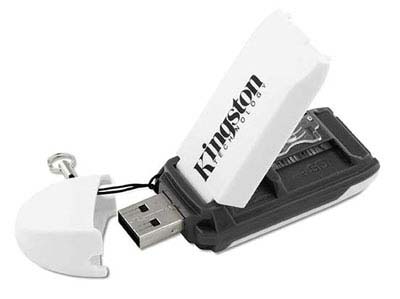Our friends at Kingston Technology, whom we often rely on for memory and storage in various devices from tiny handhelds to our media servers, have introduced a brilliant product that can accommodate all SD, microSD and miniSD card variants in one little, and amazingly inexpensive, card reader!
 In the early 1990s there was just one major memory and expansion card standard, the PC Card, or PCMCIA cards as we initially called them. Then came Compact Flash cards, Smart Media cards, Sony's Memory Stick, the MMC Card, the xD Picture card and others and plenty of variants of each. The quest was always to make cards both smaller and faster. As a result, we now have so many types of peripheral and memory card standards that it's sometimes difficult to keep track of them all, and more difficult yet to find something to plug them into and read them!
In the early 1990s there was just one major memory and expansion card standard, the PC Card, or PCMCIA cards as we initially called them. Then came Compact Flash cards, Smart Media cards, Sony's Memory Stick, the MMC Card, the xD Picture card and others and plenty of variants of each. The quest was always to make cards both smaller and faster. As a result, we now have so many types of peripheral and memory card standards that it's sometimes difficult to keep track of them all, and more difficult yet to find something to plug them into and read them!
Here's a brief description of all the formats:
MMC flash memory cards were introduced in 1997 by Siemens and SanDisk. MMC stands for MultiMediaCard. They measure 32 x 24 x 1.4 mm, have 7 pins and no write-protect tab. They've largely been replaced by SD cards. MMC cards fit into SD card slots, but not the other way around.
RS-MMC stands for "Reduced Size MultiMediaCard. They measure 24 x 18 x 1.5 mm and were introduced in 2004. They were mainly used in some Nokia and Siemens smartphones, but are not much of a factor.
MMCPlus describes full-size MMC cards (32 x 24 x 1.4 mm) that are running at higher speeds. They were introduced in 2005.
MMCmobile uses the reduced size form factor (24 x 18 x 1.5 mm) but is running at the quicker speeds specified in Version 4.x of the MMC standard. There is no write-protection switch.
MMCmicro measures 14 x 12 x 1.1 mm, just a bit different from microSD and have different pin-outs. They can be used in MMC and SD card slots with adapters.
SD, or Secure Digital, cards were developed by Toshiba, SanDisk and Matsushita, and have been available since 2000. They measure 32 x 24 x 2.1 mm, have 9 pins and a write-protect switch. Though original conceived for flash memory storage. SD caard slots are popular because they can also be used for peripherals and cards that support the SDIO (Secure Digital Input Output) standard. SD cards are now available with capacities of 8GB.
SDHC stands for Secure Digital High Capacity and uses the same 32 x 24 x 2.1mm size as standard SD cards. However, SDHC cards use different memory aaddressing and can come in sizes up to 32GB. They only work in SDHC-compatible devices.
microSD, created by SanDisk in 2005 and originally called Trans-Flash, measures 15 x 11 x 0.7 mm and is probably the smallest memory card currently on the market. It's meant as removable flash memory and used primarily in cellphones, some handheld game consoles, GPS systems, music players and so on. As of May 2007, microSD is available with capacities up to 4GB, though Samsung announced an 8GB card. They have 8 pins and no write-protect switch.
miniSD was created by SanDisk in 2003 and measures 21.5 x 20 x 1.4 mm. They were created for use in devices where a standard SD Card was already considered to big, such as small digital cameras, music players or smartphones. miniSD caards are available in capacities up to 4GB. They have 11 pins and no write-protect switch.
As you can see, that's a whole lot of card formats, and though many look almost identical and some are compatible to some extent, it can be a nightmare to read them in a PC or notebook if you have devices that use various types of cards.
Kingston Technology comes to the rescure with the MobileLite 9-in-1 USB card reader. It can read all of the above described card formats. Physically it looks like a fat USSB key measuring 3 x 1.2 x 0.6 inches. The nine card formats are accommodated in three slots, accessible by opening flaps on either side of the MobileLite. Remove the plastic cap (but don't lose it!!) on the front of the device to reveal the USB conneector used to jack into a computer. When plugged in, the MobileLite appears three drive leetters on Windows machines, and three devices on OS X Macs and Linux machines (we tried them all).
Since the MobileLite may be a little too thick and wide to fit into all USB ports, Kingston thoughtfully included a 5-inch USB adapter dongle.
The MobileLite reader sells in various configurations. The reader itself is just US$8.99. For USS$22.99 you get a reader/1GB SD card bundle, for US$23.99 a bundle with a 1GB microSD card, and for US$34.99 one with a 2GB SD Card. Highly recommended for anyone dealing with multiple card formats!
Click here to check out the Kingston MobileLite


